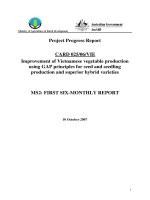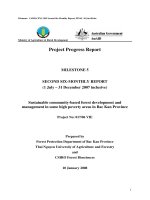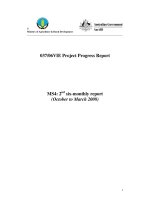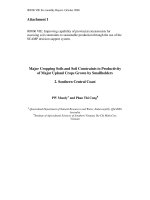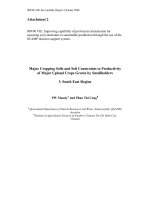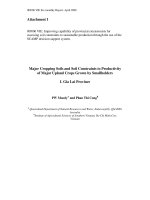Dự án nông nghiệp " Major Cropping Soils and Soil Constraints to Productivity of Major Upland Crops Grown by Smallholders - Gia Lai Province" doc
Bạn đang xem bản rút gọn của tài liệu. Xem và tải ngay bản đầy đủ của tài liệu tại đây (88.47 KB, 17 trang )
009/06 VIE Six-monthly Report- April 2008
Attachment 1
009/06 VIE: Improving capability of provincial extensionists for
assessing soil constraints to sustainable production through the use of the
SCAMP decision support system.
Major Cropping Soils and Soil Constraints to Productivity
of Major Upland Crops Grown by Smallholders
I. Gia Lai Province
PW Moody
A
and Phan Thi Cong
B
A
Queensland Department of Natural Resources and Water, Indooroopilly, Qld 4068,
Australia
B
Institute of Agricultural Sciences of Southern Vietnam, Ho Chi Minh City,
Vietnam
2
1. Introduction
The Soil Constraints and Management Package (SCAMP) has been developed
to identify soil constraints to crop production by considering a range of key soil
properties (Moody and Phan Thi Cong 2008; Moody et al. 2008). Once these
constraints have been identified, management practices that ameliorate or modify
these constraints can be formulated. Crops vary in their tolerance to soil constraints
and a soil property limiting the productivity of one crop may not be a limitation to the
productivity of another crop. Therefore, once the constraints of a particular soil type
have been identified, the soil can then be assessed for its ability to potentially support
the production of specific crops.
The objectives of this series of reports are to:
review existing information on the identification and extent of upland
cropping soils in focus provinces of Vietnam.
identify the major soils used for smallholder cropping in the focus
provinces, and determine their constraints by the application of
SCAMP.
identify the major crops/cropping systems used by smallholders in the
focus provinces, and document the specific soil requirements of these
crops/cropping systems.
link soil constraints to the soil requirements of the major upland crops
and develop management guidelines for the management of specific
soil types for specific crops.
Report I focuses on the soils and cropping systems of Gia Lai Province.
2. Major Soils used for Smallholder Cropping
The areal extents of the different soil groups (FAO-UNESCO classification)
that occur in Gia Lai Province are presented in Table 1.
Table 1. Areal extent of Soil Groups in Gia Lai Province.
Source: Le Trung Lap, 2000.
Soil Groups Area (ha) Proportion (%)
Chromic and Haplic Acrisols
Acric,Humic and Vetic Ferralsols
756,433 49
Dystric and Gleyic Arenosols
Luvisols
364,638 23
Leptosols 164,752 11
Alumic, Hyperdystric and Chromic Acrisols
Acric, humic and Vetic Ferralsols
90,481 6
Mollic Fluvisols
Luvic and Fluvic Phaeozems
Cambisols
64,218 4
Dystric Gleysols 16,774 1
Others 92,275 6
TOTAL 1,549,571
3
The land forms of Gia Lai have been classified (Berding et al., 1999) as:
Hills and low mountains,
Basaltic plateaus,
Gently to rolling uplands on metamorphic or granitic rocks or on recent
alluvium and
Depositional areas.
Topography (slope) limits the agricultural use of many areas of Gia Lai, and the major
soil groups of agricultural importance are the Ferralsols and Acrisols occurring on the
basaltic plateaus and gently to rolling uplands. These soil groups comprise about 49%
of the land surface of the province (Table 1, line 1).
3. Soil Constraints and Management Practices for Sustainable Crop Production
In a recent study (Moody et al. 2008), sites identified on the 1:100,000 soils
map of Gia Lai Province as 'Red-brown soils on basalt' (Ferralsols) and 'Grey soils on
acid igneous rocks' (Acrisols) (Le Trung Lap, 2000) were selected from the basaltic
plateaus and gently to rolling uplands areas. Fourteen Ferralsols were sampled under a
range of land uses (maize-upland rice, maize-cassava, rubber, coffee, eucalypt
plantation, fruit trees, cashew) in Dak Doa, Mang Yang, Chu Pah, Ia Grai, Duc Co,
Chu Prong and Chu Se Districts of north west Gia Lai Province. Sixteen Acrisols
were sampled from various positions (upper, mid, lower slope) in the landscape under
several land uses (maize, cassava, sugarcane, vegetables) in the vicinity of Dak Po
Village, Dak Po District in the east of Gia Lai Province.
Mini-pits were dug at each site and SCAMP Level 1 and Level 2 assessments
made (Table 2). A composite 0-15 cm soil sample was taken from each site to
represent the plough layer and analysed for Level 3 attributes (Table 2).
Table 2. Attributes determined for each application level of SCAMP.
SCAMP level Attributes
Level 1 Texture, colour (moist) of soil matrix and mottles, structure and consistence (moist),
drainage class, permeability class, slope, erosion hazard, gravel content, compaction
Level 2 Field pH (water and 1M KCl), field EC, dispersion class, infiltration rate
Level 3 Organic C, clay %, P fixation capacity, exchangeable Ca, Mg, Na and K, extractable
acidity (H +Al), ECEC, pH buffer capacity (calculated)
From these data, SCAMP (Moody and Phan Thi Cong, 2008) was used to
identify the constraints of these two major soil groups to sustainable production
(Table 3).
4
Table 3. SCAMP descriptors for 14 Ferralsols and 16 Acrisols of Gia Lai
Province, Vietnam. Number of sites with the attribute is in parentheses.
Attribute Ferralsols Acrisols
Texture L (9); LC (5) L (10); C (2); LS (4)
Erosion hazard er(slight) (9), er(moderate) (2),
er(high) (2), er(very high) (1),
er(slight) (3); er(moderate) (2);
er(high) (6); er(very high) (3);
er(extreme) (2)
Water pathway drainage (7);
drainage + runoff (7)
drainage (8);
drainage + runoff (5); runoff (3)
Acidity surface a (14); subsurface a (12) surface a (2); subsurface a (1)
Acidification hazard ar(low) (14) ar(low) (2); ar(moderate) (12);
ar(high) (2)
Low nutrient retention e (12) e (3)
High P fixation i (14)
Low organic C om (2)
Low K reserves surface k (1); subsurface k (1) surface k (1); subsurface k (7)
Variable charge characteristics geric (4)
Hard-setting hs (2)
Compaction comp (4)
These assessments indicate that the Ferralsols are predominantly loamy in
texture, with a range of erosion hazards depending on site slope. The main pathways
of water movement are by drainage or runoff plus drainage. They typically have a low
soil pH (<5.2 in water) but a low acidification hazard because of their high organic C
and clay content. ECEC is typically very low (<4 cmol
c
/kg) and they have a high P
fixation capacity. The variable charge component of several of the soils is near, or at,
the point of zero net charge (pH
KCl
-pH
water
ranging between -0.10 and 0.10).
The Acrisols are predominantly loamy in texture, although a loamy surface
over a sandy subsurface sometimes occurs. Erosion hazard ranges from slight to
extreme depending on site slope. Drainage is the main pathway of water movement in
half of the sites, with the remainder exhibiting runoff plus drainage or runoff
pathways. Acidity constraints are not common, but most of the soils have a moderate
acidification hazard because of their low clay and organic matter contents. Low
subsurface K reserves commonly occur. Hard-setting surfaces or compaction
occurred at several sites.
The main constraints identified for the Ferralsols were acidity (a), low nutrient
retention (e), high P fixation (i), and variable charge characteristics (geric), with
drainage being the most common pathway of water movement (Table 2). With these
constraints, the SCAMP database would indicate the following management strategies
for sustainable productivity:
a: Acid tolerant crops should be grown as a short term response to this constraint.
For long term sustainability, a liming program should be commenced with regular
monitoring of soil pH.
e: CEC should be increased by increasing soil organic matter content (retaining
crop residues, adding organic residues, growing cover crops or companion green
manure crops) in association with a liming program to increase soil pH and therefore
the variable charge component of CEC (e.g., Aitken et al., 1998; Phan & Merckx,
2005). The practicality of adding high activity clays to increase permanent charge
could be assessed (e.g., Noble et al., 2004).
i: The high P-fixation capacity indicates that high rates of P fertiliser will be
required or special P management practices (i.e. sources and method of P fertiliser
5
application) will need to be implemented. P fertilization in minimum input cropping
systems should be directed toward the use of minimal P rates applied in bands or
pockets close to the seed, and the use of crops with low P-demand. Band or spot
placement of water-soluble P fertiliser applications will decrease the loss of P
availability by fixation. However, such placement will concentrate roots around the
fertiliser and this may reduce root exploration of the soil profile. In areas that have
short term droughts, this may limit yield because of restricted root access to soil
water. An initial, reduced rate, broadcast fertiliser application accompanying a banded
application should allow a more uniform root distribution. Soil P test levels should be
determined periodically to monitor soil P status.
geric: These soils have little net variable surface charge and therefore they have a
very limited capacity to retain nutrient cations (eg. calcium and potassium) or anions
(eg. nitrate) in the surface soil. Fertiliser will need to be applied in small frequent
applications in accord with crop nutrient demands. Liming the surface soil to pH (in
water) 5.5 will increase the ability of the soil to retain cations by increasing net
negative variable charge, and this is an important management option. Addition of
organic materials such as green manure crops should be considered because this may
also increase net negative variable charge.
With respect to the Acrisols, the most commonly identified constraints were low-
moderate organic matter ratings, low K reserves particularly in subsurface layers, and
the soil physical problems of hard-setting surfaces and compaction. Some individual
sites suffered from impeded drainage leading to waterlogging and ponding of water.
To address these constraints, the SCAMP database would indicate the following
management strategies:
om (low-moderate): Increasing the levels of organic matter in these soils would
improve nutrient supply, increase CEC, increase water holding capacity and increase
pH buffer capacity. The management of soil organic matter in tropical soils involves
mulching and incorporation of ‘green manure’ crops such as legumes or forage
grasses, retaining all crop residues in the field where the crop has grown, not burning
crop residues, minimum or zero tillage farming systems, strip or alley cropping and
application of organic materials (such as animal manure, composted municipal waste,
sewage sludge, and locally available industrial organic wastes) obtained from off-site.
k: Potassium fertilisers or organic amendments having a significant content of K
will need to be applied. In soils with low K reserves in the subsurface layer, it is likely
that crops will exhibit K deficiency during periods of drought. In these circumstances,
placement of K fertilisers below the seed at sowing or mixing K fertiliser through the
soil in the planting hole is a more efficient management strategy than sidedressing K
fertilisers on the soil surface. Crops should be closely monitored for K deficiency
symptoms.
hs, comp: Hard-setting surfaces reduce infiltration rate and cause poor crop
establishment, while compaction layers restrict root growth and limit rooting depth
causing drought stress to crops. Retaining crop residues and applying surface mulch
should be used to maintain soil surface moisture thus minimising hard-setting. To
minimise compaction risk, soils should only be cultivated when drier than their plastic
limit, and tillage and machinery traffic should be avoided when soil is wetter than its
plastic limit.
6
4. Major Upland Crops grown by Smallholders
Agricultural census data were used to identify the major upland crops grown
by smallholders in Gia Lai. Crop areas are presented in Table 4. Crops occupying
greater than 5% of the arable land are: rice, maize, cassava, sugarcane, rubber and
coffee. Rubber is not grown by smallholders.
Table 4. Crop areas of Gia Lai Province. Smallholder crops are shaded.
Crop
Area
(ha)
Proportion
(%)
Rice 63883 20.4
Maize
40486
12.9
Cassava
24297
7.8
Vegetables
7618
2.4
Peanut
3787
1.2
Soybean
35
0.0
Tobacco
2350
0.8
Sugarcane
15543
5.0
Cotton
5184
1.7
Rubber
57307
18.3
Coffee
77530
24.8
Cashew
12354
3.9
Pepper
2609
0.8
TOTAL 312983
5. Soil Suitability for Major Upland Crops grown by Smallholders
SCAMP assessments of the Ferralsols and Acrisols (Section 3 above) have
identified several soil constraints to crop productivity. Several of these constraints
have effects on crop productivity, irrespective of the crop grown: erosion (er), low
CEC (e), high P fixation (i), low organic carbon (om), K deficiency (k), variable
charge characteristics (geric), hardsetting characteristics (hs) and compaction layers
(comp). However, crops vary in their tolerance to other constraints such as drainage
and acidity; while a particular soil attribute or constraint might be a major limitation
to the productivity of one crop, it may pose only a minor limitation to another. The
FAO (1976) framework for land evaluation uses five classes to categorise the
suitability of a specific soil/landscape unit for growing a particular crop (Table 5). To
facilitate the use of SCAMP for this application, individual soil attributes/constraints
identified for the Ferralsols and Acrisols have been rated according to their effects on
the sustainable production of the major upland crops grown by smallholders in Gia
Lai (Table 6). Ratings are based on collation of information in Williams (1975),
Landon (1984), Page (1984), Schaffer and Andersen (1994), Robinson (1996) and
Dierolf et al. (2001).
7
Table 5. Soil suitability classes [Source: FAO 1976]
Suitability
Class
Criterion Description
1 Highly suitable Soil is suitable for sustainable
production of the crop without
ameliorative measures.
2 Moderately suitable Soil is suitable for sustainable
production of the crop if minor
ameliorative measures are applied (e.g.
liming, mounding to improve local
drainage).
3 Marginally suitable Soil is only suitable for sustainable
production of the crop if major
ameliorative measures are undertaken
(e.g. large scale drainage works).
4 Currently not suitable Soil is not suitable for sustainable
production of the crop.
Table 6. Suitability class of soil attributes/constraints for production of specific
crops.
SCAMP
descriptor
Paddy
rice
Maize Cassava Sugarcane Coffee
Texture
S 4 2 2 2 2
L 1 1 1 1 1
C 1 1 2 1 1
O 4 3 2 3 3
Drainage
1 (g) 2 4 4 4 4
rating
2 (g
-
) 1 4 3 3 4
3 3 3 3 2 3
4 4 1 2 1 2
5 4 1 1 1 1
6 4 1 1 1 1
Slope (%)
0-2 1 1 1 1 1
2-5 2 1 1 1 1
5-10 3 2 2 2 2
>10 4 3 3 2 3
Soil pH
a
-
1 2 1 1 2
a
2 3 2 2 3
Salinity
s
-
s
2
3
3
4
3
4
2
4
3
4
Drought tolerance
L L H L L
Main nutrient
/water uptake zone
(cm)
<50 80-100 >100 >100 >100
Nutrient
needs
High N
req'd
High N, K
req'd
Tolerates
low
fertility
High N req'd High N, K
req'd
8
The following comments apply to the management practices that may need to
be undertaken to meet the requirements of individual crops in addition to those
already outlined in Section 3 above.
Texture
S: Because of the low inherent plant available water content of sandy soils,
irrigation may be required for crops of low drought tolerance such as maize,
sugarcane and coffee. Using surface mulches of plant residues will reduce evaporation
and conserve soil moisture.
For crops with high nutrient demands such as maize, sugarcane and coffee, the
low ECEC of sandy soils requires that nutrient cations such as potassium are applied
in split applications at rates in accord with crop demand. Growing green manure crops
or applying plant material from these crops (eg. Tithonia) will temporarily increase
the nutrient holding capacity (i.e. CEC) of the soil.
C: Root crops such as cassava are not suited to clayey soils because of
harvesting difficulties.
Clayey soils are unsuitable for crops that do not tolerate prolonged soil
wetness such as coffee; the low permeability of clayey soils causes them to remain
wet for a longer period than soils of lighter texture.
Drainage
Soils with imperfect or poor drainage are unsuitable for crops that cannot
tolerate waterlogged conditions such as coffee and maize, and raised beds and large
scale drainage works must be undertaken if such crops are to be grown.
Acidity
a: Soils with this constraint are unsuitable for crops with a low or moderate
tolerance to Al and/or Mn toxicity such as maize and coffee unless a comprehensive
liming program is undertaken.
a
-
: These soils require a liming program if they are being used to grow crops
of low tolerance to Al toxicity such as maize and coffee. Applying Tithonia residues
to acidic soils has been shown to ameliorate soil acidity by increasing soil pH. An
added benefit of using fused magnesium phosphate (FMP) as a P fertiliser is that it
also has a liming effect.
Main nutrient/water uptake zone
Crops with a comparatively shallow active rooting depth will not be as
sensitive as deeper rooted crops such as coffee and sugarcane to constraints such as a
compaction layer (comp).
Conclusions
Ferralsols and Acrisols are the major arable soil groups in Gia Lai. The
constraints to crop production which commonly occur in the Ferralsols are acidity,
low nutrient cation retention, high P fixation and variable charge characteristics, with
drainage being the most common pathway of water movement. For Acrisols,
commonly occurring constraints are low-moderate organic matter ratings, low K
reserves particularly in subsurface layers, and the soil physical problems of hard-
setting surfaces and compaction. Some Acrisols have impeded drainage leading to
waterlogging and ponding of water.
9
The crops most commonly grown by smallholders in the province are: paddy
rice, maize, cassava, sugarcane and coffee. Individual crop tolerances to some of the
identified constraints vary, and so soil management responses to ameliorate or
minimise the effects of these constraints on crop productivity will also vary. However
the use of a liming program and application of green manures to the Ferralsols is
required by all crops, while improving drainage, maintaining a surface mulch, and
applying green manures are essential practices for the Acrisols.
References
Aitken, R.L., Moody, P.W. & Dickson, T. 1998. Field amelioration of acidic soils in
south-east Queensland. I. Effect of amendments on soil properties. Australian
Journal of Agricultural Research, 49, 627-637.
Berding, F.R., Tran Mau Tan, Truong Dinh Tuyen, Tran Van Hue, Deckers, J. &
Langhor, R. 1999. Soil Resources of Gia Lai Province. National Institute of
Agricultural Planning and Projection (Vietnam) and Katholieke Universiteit
Leuven (Belgium).
Dierolf, T., Fairhurst, T. and Mutert, E. 2001. Soil Fertility Kit. Potash and Phosphate
Institute: Singapore.
FAO. 1976. Framework for land evaluation. Soils Bulletin No. 32. FAO:Rome.
Landon, J.R. (ed.) 1984. Booker Tropical Soil Manual. Longman Inc.: New York
Le Trung Lap 2000. Land use and sustainable development for soil resources of Gia
Lai Province. Proceedings of Workshop on Environment and Sustainable
Development of the Central Highland. Pleiku, Sept 2000. Department of
Science, Technology and Environment, Pleiku.
Moody, P.W. and Cong, P.T. 2008. Soil Constraints and Management Package
SCAMP): guidelines for sustainable management of tropical upland soils.
ACIAR Monograph No. 130, 86pp. Australian Centre for International
Agricultural Research, Canberra.
Moody, P.W., Phan Thi Cong, Legrand, J.
& Nguyen Quang Chon 2008.
A framework for identifying soil constraints to the agricultural productivity of
tropical upland soils. Soil Use and Management, 24, 148-155.
Noble, A.D., Ruaysoongnern, S., Penning de Vries, F.W.T., Hartmann, C. & Webb,
M.J. 2004. Enhancing the agronomic productivity of degraded soils in
northeast Thailand through clay-based Interventions. In: Water and
Agriculture (eds. Seng, V., Craswell, E., Fukai, S. & Fischer, K.), ACIAR
Proceedings No. 116, ACIAR, Canberra, pp. 147-160.
Page, P.E. 1984. Tropical Tree Fruits for Australia. QDPI Information Series QI
83018. Queensland Department of Primary Industries: Brisbane.
Phan & Merckx Phan, T.C. & Merckx, R. 2005. Improving phosphorus availability in
two upland soils of Vietnam using Tithonia diversifolia H. Plant and Soil,
269, 11-23.
Robinson, J.C. 1996. Bananas and Plantains. CAB International: Oxon.
Schaffer, B. & Andersen, P.C. 1994. Handbook of Environmental Physiology of Fruit
Crops. CRC Press: Florida.
Williams, C.N. 1975. The Agronomy of the Major Tropical Crops. Oxford University
Press: London.
009/06 VIE Six-monthly Report_April 2008
1
Attachment 2
009/06 VIE: Improving capability of provincial extensionists for assessing soil constraints
to sustainable production through the use of the SCAMP decision support system.
SCAMP Training Course Gia Lai: March 2008
Pre- and Post- training survey
The 85 participants at the training course were given a pre- and post-course questionnaire. The pre-course
questionnaire was designed to determine what the participants considered were the major soil constraints
to productivity in their district. The post-course questionnaire was designed to measure any changed
perceptions of major soil constraints and to determine what follow-up actions the participants planned to
take when they returned from the course.
Pre-course survey
The two major cropping soil groups of the Central Highlands are Ferralsols and Acrisols. These soils are
contrasting in terms of position in the landscape, drainage, texture and clay mineralogy and it was
expected that a wide range of perceived soil constraints would be nominated by the participants,
depending on the soil type in their local area. Table 1 indicates that soil acidity, organic matter content,
slope and erosion and nutrient deficiencies were perceived to be the major constraints. Other important
constraints such as soil compaction, clay dispersion and shallow rooting depth were not perceived to be
important constraints.
Table 1. Soil properties/constraints which are perceived to be related to the decline in soil productivity
in Gia Lai Province.
Soil properties Pre-course Post-course
(%) (%)
1 pH 35.7 33.3
2 Texture 16.7 31.0
3 Organic matter content, humus 21.4 31.0
4 Drainage 19.0 9.5
5 Structure, aggregation 14.3 16.7
6 Erosion, slope 21.4 42.9
7 Rooting depth 11.9 4.8
8 Compaction 4.8 9.5
9 Porosity, aeration 9.5 11.9
10 Color 7.1 4.8
11 Clay dispersion 0.0 4.8
12 Nutrient deficiencies 23.8 14.3
13 Concretion 2.4 0.0
14 EC 2.4 0.0
15 P-fixing capacity, available P 2.4 31.0
009/06 VIE Six-monthly Report_April 2008
2
Post-course survey
It was apparent from the post-course survey that the awareness of the participants of some soil
constraints had been greatly increased. In particular, the importance of soil texture and soil organic
carbon in determining many fundamental soil properties was recognised (Table 1). Awareness of
erosion as a soil constraint also increased as a result of the course. However, the stand-out issue where
there was a very large increase in awareness was phosphorus availability. It is very likely that the initial
general perception of 'nutrient deficiencies' as a major limitation to productivity included phosphorus
deficiency, but the knowledge of the participants was not sufficient to allow them to separate
phosphorus from other nutrients. The course specifically dealt with phosphorus as a common deficiency
in many upland soils, and this allowed the participants to refine their knowledge about nutrient
constraints.
Knowledge gaps
Participants identified the major gaps in their knowledge were how to formulate a fertilizer
recommendation and how to maintain nutrient balance nutrient in the soil (Table 2). It was perceived
that training in SCAMP Level 3 (which includes measurements of soil organic carbon and extractable
soil phosphorus and potassium) might address this gap, combined with on-site soil analyses being
undertaken on local soils using a mobile lab.
Table 2. Topics in which participants felt they needed more post-course training.
Issue (%)
Balanced nutrient/fertilization 47.6
How to make fertilizer recommendation for major crops 90.5
More field practice on more soil types 66.7
More training courses for other farmers 19.0
Produce seeds of green manures 35.7
SCAMP Level 3 training 81.0
Mobile lab application 69.0
Future action plans
The future action plans of the participants primarily involve the dissemination of SCAMP training to other
extensionists, farmer associations and farmers at village level (Table 3), with a major emphasis on soil-
specific management and erosion control. The use of leguminous green manure crops to control erosion
and to provide nitrogen to replace chemical fertilizers (thus reducing investment costs) was one
management strategy that many course participants intend to promote. There is also the intention to map
soil constraints at local level.
009/06 VIE Six-monthly Report_April 2008
3
Table 3. What actions are the participants planning to undertake with their local farmer networks after
coming back from the workshop.
(%)
Organize SCAMP training course for the village leaders (down to
hamlet level)
28.6
Apply erosion control with leguminous/vetiver contour
lines
45.2
Make a soil constraint map of their village 14.3
Recommend proper management practices for the soils in their
villages based on SCAMP
61.9
Save money to buy pH and EC meters 7.1
Suggest farmers measure pH, EC and analyse their soil before apply
fertilizer
7.1
Make use of different amendment sources, e.g. green manure crops,
crop residues, animal manure
11.9
Improve soil microbiological activity 19.0
Conclusion
The pre- and post-course questionnaires have indicated some major shifts in the perceptions of
extensionists as a result of the course. In particular, soil specific management and a better
understanding of specific nutrient deficiencies should result in better on-ground soil management at
the farm scale. It was clearly the desire of the extensionists to pass on their knowledge to farmers.
In terms of the project, it is apparent that including local soil testing by a mobile lab, and interpreting
these results in the local context will greatly increase the impact of the training. This aspect will be
included in the agendas of the two remaining training courses of the project. In addition, a section of
the training courses will be devoted to describing how a SCAMP assessment of a soil can be used to
design simple field experiments to demonstrate improved practices.
009/06 VIE Six-monthly Report- April 2008
1
Attachment 3
009/06 VIE: Improving capability of provincial extensionists for assessing
soil constraints to sustainable production through the use of the SCAMP
decision support system.
Summary of Demonstration Field Experiment- Central
Highlands
Introduction
Sustainable agricultural systems are based on managing soils according to their
capabilities and environmental constraints. The productive capacity of a soil is
determined by key soil properties: some are intrinsic (such as texture and structure) while
others (such as pH and organic matter content) can be manipulated by management.
Knowledge of the intrinsic properties of a soil enables inferences to be made about
derived properties such as CEC and pH buffer capacity. From these inferences,
management strategies can be developed for maximising the productive capacity of the
soil.
To facilitate the interpretation of upland soil properties for identifying soil constraints and
appropriate management strategies, a decision support framework ‘Soil Constraints and
Management Package’ (‘SCAMP’) was developed in ACIAR project SMCN 2002/085.
In this project SCAMP was used to identify the commonly occurring constraints in
Ferralsols- a major soil type used for cropping in Gia Lai Province. Fourteen Ferralsols
were sampled under a range of land uses (maize-upland rice, maize-cassava, rubber,
coffee, eucalypt plantation, fruit trees, cashew) in Dak Doa, Mang Yang, Chu Pah, Ia
Grai, Duc Co, Chu Prong and Chu Se Districts of north west Gia Lai Province.
Mini-pits were dug at each site and SCAMP was used to identify the constraints of the
site to sustainable production. The main constraints identified were: acidity (a): 14 sites;
low nutrient retention (e): 12 sites; high P fixation (i): 14 sites; variable charge
characteristics (geric): 4 sites; erosion hazard (er) ranged from slight (9 sites) to very high
at 1 site. Drainage was identified as the predominant pathway of water movement.
With these constraints, the SCAMP database would indicate the following management
strategies for sustainable productivity:
a: Acid tolerant crops should be grown as a short term response to this constraint. For
long term sustainability, a liming program should be commenced with regular monitoring
of soil pH.
009/06 VIE Six-monthly Report- April 2008
2
e: CEC should be increased by increasing soil organic matter content (retaining crop
residues, adding organic residues, growing cover crops or companion green manure
crops) in association with a liming program to increase soil pH and therefore the variable
charge component of CEC. The practicality of adding high activity clays to increase
permanent charge could be assessed.
i: The high P-fixation capacity indicates that high rates of P fertiliser will be required
or special P management practices (i.e. sources and method of P fertiliser application)
will need to be implemented. P fertilization in minimum input cropping systems should
be directed toward the use of minimal P rates applied in bands or pockets close to the
seed, and the use of crops with low P-demand. Band or spot placement of water-soluble P
fertiliser applications will decrease the loss of P availability by fixation. However, such
placement will concentrate roots around the fertiliser and this may reduce root exploration
of the soil profile. In areas that have short term droughts, this may limit yield because of
restricted root access to soil water. An initial, reduced rate, broadcast fertiliser application
accompanying a banded application should allow a more uniform root distribution. Soil P
test levels should be determined periodically to monitor soil P status.
geric: These soils have little net variable surface charge and therefore they have a
very limited capacity to retain nutrient cations (eg. calcium and potassium) or anions (eg.
nitrate). Fertiliser will need to be applied in small frequent applications in accord with
crop nutrient demands. Liming the surface soil to pH (in water) 5.5 will increase the
ability of the soil to retain cations by increasing net negative variable charge, and this is
an important management option. Addition of organic materials such as green manure
crops should be considered because this may also increase net negative variable charge.
To validate the applicability of the formulated management strategies, a field site on a
Ferralsol was selected in Ia Grai District (N13
o
58.01
'
, E107
o
52.98
'
). Some properties of
the soil are presented in Table 1.
Table 1. Some properties of the field site soil (0-15 cm).
Soil pH
(
water)
pH
(
KCl)
EC
1:5
(dS/m)
Organic
C (%)
Exch K
(cmol
c
/kg)
ECEC
(cmol
c
/kg)
Olsen P
(mg/kg)
PBI Clay
(%)
Geric
Ferralsol
5.0 4.2 0.05 3.0 0.08 0.44 9 1040 75
The SCAMP constraints identified for this Ferralsol site were acidity (a), high P fixation
(i), low CEC (e), and low K (k). Treatments designed to minimise the effects of the
identified constraints on productivity were compared with 'local farmer practice' using
maize as the test crop over a period of 3 years (Table 2). The final year (2007 cropping
season) comprised the demonstration trial used to support the SCAMP training workshop
held in Gia Lai as a component of this project.
009/06 VIE Six-monthly Report- April 2008
3
Individual plot size comprised 5m of 4 double rows of maize at 1.5 m spacings. There
were 4 replicates arranged in a randomised block design. Erosion control measures were
implemented by planting contour rows of green manure crops and vetiver grass.
009/06 VIE Six-monthly Report- April 2008
4
Table 2. Treatments at the Ia Kha field experiment on a Ferralsol. Maize was the
test crop. Benefit/Cost ratios were calculated as Gross Return/Gross Inputs. Gross return
comprises sale of grain. Gross inputs comprise fertiliser costs, and labour costs associated
with collecting the locally available green manure Tithonia. For calculating the cost of
bentonite additions, 1/5 of the initial cost of each of the additions was used each year
(assumes a 5 year residual value) and for the silicate, 1/3 of the initial cost of the addition
was used each year (assumes a 3 year residual value).
2005 cropping season
Treatment Grain Yield
(T/ha)
Benefit/Cost
1. Farmer's practice (71N, 21P, 20K, 39S) 0.2 d -0.4
2. High P recommendation (115N, 57P, 140K) 1.8 bc 1.3
3. Bentonite @ 5T/ha (115N, 42P, 140K) 2.3 ab 1.4
4. Tithonia @ 10 kgP/ha incorporated (115N, 42P, 140K) 2.3 ab 2.7
5. Tithonia + bentonite (115N, 42P, 140K) 2.8 a 2.3
6. Dispersed P (115N, 42P, 140K) 1.4 c 1.1
7. Banded P (115N, 42P, 140K) 1.6 c 1.2
2006 cropping season
Treatment Grain
Yield
(T/ha)
Benefit/Cost
1. Farmer's practice (94N, 21P, 20K, 39S) 1.1 d 0.8
2. High P recommendation (115N, 57P, 100K) 4.4 ab 2.6
3. Bentonite @ 5T/ha (115N, 42P, 100K) 4.2 b 1.2
4. Tithonia @ 3.5 kgP/ha incorporated (115N, 42P, 100K) 4.7 a 3.6
5. Tithonia + bentonite (115N, 42P, 100K) 4.4 a 1.4
6. Dispersed P (115N, 42P, 100K) 3.8 bc 2.4
7. Banded P (115N, 42P, 100K) 3.8 c 2.3
2007 cropping season
Treatment
Grain
Yield Benefit/Cost
(T/ha)
1. Farmer's practice (115N, 24P, 50K, 39S) + 750 kg Tithonia
1.2 1.5
2. High P recommendation (115N, 57P, 50K)
3.0 2.8
3. Residual bentonite (115N, 29P, 50K)
3.6 2.3
4. Residual Tithonia (115N, 29P, 50K)
3.4 3.9
5. Residual Tithonia + bentonite (115N, 29P, 50K)
3.4 2.1
6. Dispersed P (115N, 29P, 50K)
3.1 3.6
7. Calcium silicate (115N, 29P, 50K)
2.9 1.9
For Treatments 2-7, fertiliser applications were split: 30%N, 40%K, 100%P at planting
30%N, 20%K 30 DAS
40%N, 40%K 60 DAS
009/06 VIE Six-monthly Report- April 2008
5
Results
Results from the final year of the experiment indicated that yield increased in the order:
farmer practice<calcium silicate=high P recommendation=dispersed P<residual bentonite
= residual Tithonia = residual Tithonia plus bentonite. The reason for the poor yield in the
Farmer's Practice relative to the same total nutrient inputs in other treatments was caused
by the farmer splitting the application of the blended N-P-K fertiliser. While this practice
is efficient for the application of N and K, splitting the application of P did not provide
sufficient P at planting to meet crop requirements. Plant weight and plant chemical
analyses determined at 35 days after sowing indicated low yield and P content in
Treatment 1 relative to the other treatments. This result highlights the benefits of using
'straight' fertiliser forms rather than blends or compound fertilisers.
In the first two seasons, soil and plant analyses indicated that as well as providing 'slow
release' N and P, Tithonia increased soil pH (thus ameliorating Al toxicity) and increased
ECEC. Bentonite application also increased ECEC, preventing the leaching of added K
into the subsoil. These results confirm the constraints identified in the SCAMP analysis of
this Ferralsol and support the management strategies suggested in SCAMP for
minimising the impacts of these constraints on productivity.
Benefit /Cost ratios in the final cropping season indicated that the residual effects from
the application of Tithonia alone for the 2 previous years gave the highest returns.
Although the bentonite treatments gave similar high yields to the Tithonia treatments, the
initial high cost of purchasing the bentonite (even though this was spread over 5 years)
would make it less attractive as a management option than collecting the locally available
Tithonia for use as a green manure/soil amendment. Throughout the entire 3 year
cropping cycle, the application of Tithonia as a soil amendment consistently out-
performed 'farmer practice' in terms of yield and B/C ratio.
Conclusion
These results demonstrate how SCAMP can be used to assess soil constraints to
productivity and how, based on this information, management strategies can be identified
to minimise the effects of these constraints on productivity. The profitability of these soil-
specific management strategies has been demonstrated in the field experiment. However,
the biggest barrier to adoption is the initial capital outlay required for
fertilisers/amendments and for labour associated with collecting the green manure crop.
Advancing initial capital costs from a funding source on the basis of an expected
profitable return on investment would be a very valuable mechanism for 'kick-starting'
improved soil management practices that are supported by sound science.


